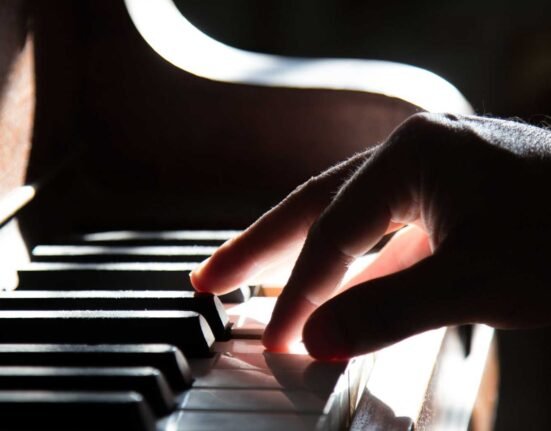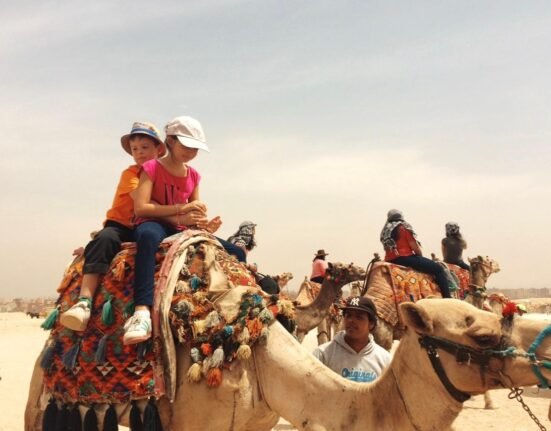Understanding Pascha
Greek Orthodox Easter, known as Pascha, crowns the celebrations of the Eastern Orthodox Church. The word “Pascha” derives from the Greek term that transliterates the Hebrew word “pesach,” meaning Passover. Pascha is the most ancient and significant festival in the Orthodox Christian calendar. It commemorates the resurrection of Jesus from the dead after the crucifixion. Often called Resurrection Day or Resurrection Sunday, Pascha embodies the essence of hope and renewal.
During this time, rich religious ceremonies, age-old customs, and vibrant culinary traditions fill communities across Greece. For expatriates and foreigners, understanding this significant event provides unique insights into the culture and traditions of Greece.

Pascha’s Movable Nature and a Rare Occurrence in 2025
Pascha is a movable feast, meaning its date varies each year according to the Paschalion system, often resulting in it falling on different dates than Easter celebrations in Western Christianity, including Catholic and Protestant denominations. While Orthodox Easter typically occurs one week later, there are special occasions when it is celebrated on the same date. Notably, 2025 represents a rare occurrence, as both Orthodox and Catholic Easter will align on Sunday, April 20. This alignment presents a unique opportunity for Christians from all traditions to celebrate together, fostering a spirit of unity and shared faith.
Lenten Preparations
The journey toward Easter begins with Clean Monday, or Kathara Deftera (March 3, 2025). This day marks the start of Great Lent, a 40-day period of fasting and reflection. Many people choose to abstain from animal products, although some are more lenient with dairy and eggs. Others simply limit their meat intake instead of fasting completely.
Lazarus Saturday (April 12, 2025) concludes Great Lent. It commemorates the raising of Lazarus from the dead. This event signifies the promise of universal resurrection and serves as a bridge to Holy Week, highlighting the anticipation of Christ’s crucifixion.
Holy Week Rituals
Holy Week (April 13 – April 20, 2025) immerses participants in the last days of Jesus. Each day is dedicated to remembering His teachings and sacrifices. Orthodox Holy Week begins the week after Lazarus Saturday and concludes with Easter Sunday.
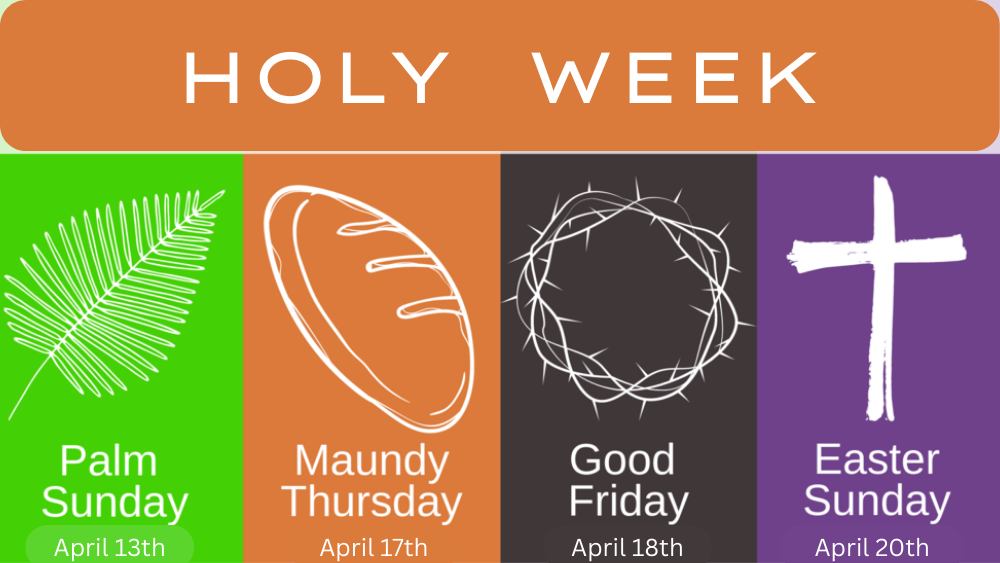
Key Events of Holy Week
- Palm Sunday (April 13, 2025): This day marks Christ’s triumphal entry into Jerusalem. Celebrations include services held under palm branches, emphasizing the significance of the event.
- Holy Monday (April 14, 2025): Here, the focus remains on Christ’s final instructions to His disciples. Services, including the Great Compline and Matins, underscore the importance of vigilance and preparedness.
- Holy Tuesday (April 15, 2025): This day reinforces themes of readiness and awareness as participants reflect on Christ’s teachings leading to His passion.
- Holy Wednesday (April 16, 2025): Sometimes known as Spy Wednesday due to Judas’s betrayal, this day commemorates Christ’s anointing with myrrh. It includes the Mystery of Holy Unction , where the faithful receive anointing with holy oil, symbolizing healing.
- Holy Thursday or Maundy Thursday (April 17, 2025): The day begins with the Divine Liturgy of St. Basil (Holy Eucharist), representing the Last Supper. Evening services consist of the reading of the Twelve Gospels, detailing Christ’s final instructions.
- Good Friday or Great Friday (April 18, 2025): This day is marked by profound mourning. Participants attend the Royal Hours service and the Epitaphios procession, carrying the icon of the crucified Christ in solemn remembrance.
- Holy Saturday (April 19, 2025): This day features Vespers and the Divine Liturgy of St. Basil , focusing on Christ’s descent into Hades and marking the transition to Pascha.
- Easter Sunday (April 20, 2025): Easter Sunday, marking the end of Holy Week and Lent, is one of the most joyous celebrations for Christians worldwide as it commemorates the resurrection of Jesus Christ.
Let’s Zoom in on the Last Days Leading to Pascha
Holy Thursday
On Holy Thursday, the Greek Orthodox Church commemorates one of the most somber days of Holy Week, marking the last day of Jesus Christ on Earth. This day is closely tied to the Last Supper, where Jesus shared His final meal with His disciples, emphasizing humility and service. During this sacred gathering in Jerusalem, He washed the feet of His disciples—an act traditionally reserved for servants—teaching them vital lessons in humility and selflessness.
Observances across Greece feature reenactments of these pivotal moments. In the morning, many communities participate in representations of the Last Supper and the institution of the Eucharist. As evening approaches, congregants gather in churches to decorate the epitaph, a symbolic representation of Christ’s burial, with flowers and other adornments. The atmosphere is filled with sorrow as mournful hymns resonate, echoing the anguish of Jesus’ impending sacrifice.
Meanwhile, homes come alive with the preparation of traditional tsoureki, a sweet Easter bread that features three braided plaits, symbolizing the Holy Trinity —God, Christ, and the Holy Spirit. This delicious bread is infused with aromatic spices such as mahleb, and mastic, which enhance its rich flavor and contribute to its unique aroma. Additionally, traditional Easter cookies known as koulourakia Lambriatika or lamprokouloura are made throughout nearly all of Greece.
As families engage in these time-honored culinary traditions, they also dye dozens of eggs in brilliant red to represent the blood of Christ. The hard eggshell symbolizes the sealed tomb of Jesus, while the red color signifies the blood and suffering endured during the crucifixion. It’s important to remember that eggs have been a symbol of renewal and life since antiquity. The activities of Holy Thursday embody a deep spiritual significance as communities reflect on their faith and prepare for the solemn days to follow.



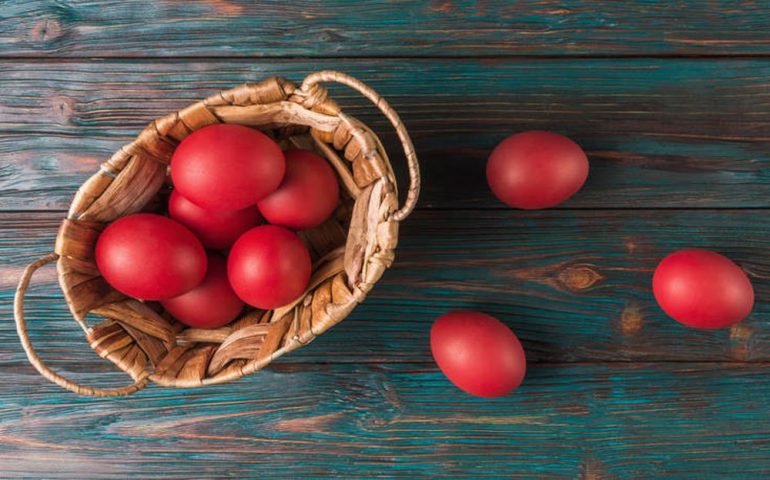
Good Friday: The Epitaph
On Good Friday, a day immersed in solemnity, the Greek Orthodox Church commemorates the Passion of Christ, reflecting on the profound sorrow surrounding His crucifixion. Throughout this sacred day, church bells toll slowly, flags are flown at half-mast, and normal work activities are often suspended. When meals are prepared, they adhere to fasting traditions, typically consisting of simple boiled foods without oil to honor the solemn nature of the day.
Within every church, the Easter Epitaph —a symbolic funeral bier representing Jesus Christ—is prominently displayed. This wooden bier is lavishly adorned with fresh flowers, carefully arranged to create a vibrant display that complements the solemnity of the occasion. The blooms, often in shades of white, red, and purple, are fixed to the structure of the Epitaph, enhancing its beauty and significance. Alongside the flowers, candles and incense contribute to a sacred atmosphere, inviting the faithful to pause and reflect on the meaning of Christ’s sacrifice. As members of the faithful arrive to pay their respects, a line forms outside each church, where individuals approach the Epitaph to kiss the icon of Christ, gently taken down from the cross and wrapped in linen.
As dusk approaches, the Epitaph of each church is brought out for a pious procession, with the surrounding streets closed to accommodate this revered observance. The clergy and altar boys, dressed in ornate liturgical robes, lead the way as young men from the congregation carry the Epitaph through the streets.
The atmosphere is illuminated by the soft glow of candlelight, as attendees follow closely, each holding a candle and softly chanting hymns, including the beloved “Oh My Sweet Springtime,” “Ω γλυκύ μου έαρ”. The enchanting scent of flowers fills the air, creating an unforgettable scene. Some spectators opt to remain on their balconies , holding their candles aloft, enhancing the beauty and reverence of this sacred moment as the processions weave through the night.

Easter Saturday: Embracing the Light
Good Friday gives way to Easter Saturday, the atmosphere shifts to one of anticipation and joy. Ceremonies highlight the victory of light over darkness, beginning with the transfer of the Holy Fire, known in Greek as Ἃγιον Φῶς”, “Agio Phōs, from the Holy Sepulchre in Jerusalem.

The Spectacle of Midnight Mass
As night approaches, excitement fills the air. Community members gather at churches for Midnight Mass. Participants arrive from 10 PM onward, eager to hold white candles, while children carry special candles known as lambathas, adorned with ribbons and Easter symbols—gifts from their godparents.

As midnight draws near on Holy Saturday, a hush falls over the gathering, and the church lights are extinguished, enveloping the space in a profound sense of mysticism. The priest lights his candle from the Eternal Flame of the Holy Fire and proclaims, “Christos Anesti” (Christ is risen!). This powerful declaration resonates through the congregation as the flame spreads from candle to candle, transforming a single light into a sea of flickering candles that symbolize the arrival of salvation.
At the stroke of midnight, the moment believed to mark Jesus Christ’s resurrection, the priest raises his candle and invites everyone with a joyful, “Come and get the light!” The Holy Flame is subsequently shared throughout the congregation, with each individual responding to “Christos Anesti” with “Alithos Anesti” (Verily, He is Risen), filling the church with light and warmth.
A sense of joy permeates the atmosphere as church bells toll across the land. Fireworks illuminate the night sky, adding to the celebration’s magic, while the excitement of firecrackers sometimes drowns out their voices, further enhancing the festive spirit.
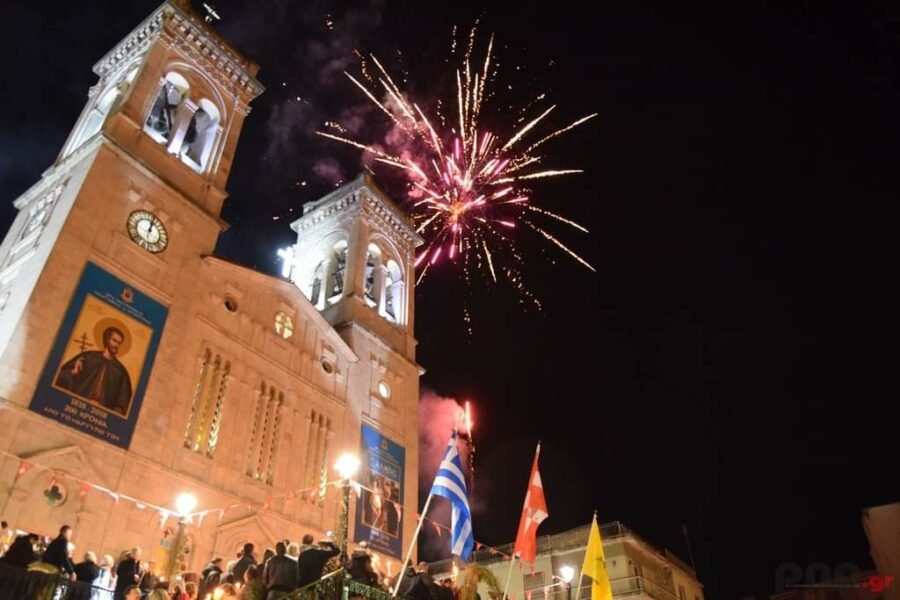
The Resurrection of Christ, known as “Ανάσταση” (Anastasi) in Greek, is celebrated at midnight with fireworks illuminating the sky, as church bells ring and the hymn “Christos Anesti” (Christ is Risen) is joyfully chanted by the congregation. Image Credit: ifarsala.gr

A Midnight Easter Feast
Once families return home from church, they bless their homes by smudging the sign of the cross above their doors with their still-lit candles. It’s time for the cherished traditional Easter supper, which often marks the first meat enjoyed since Lent began 40 days earlier.
The main dish is magiritsa, a comforting soup made from the innards of the lamb that will be roasted the following day. This dish includes spring onions, dill, and rice, thickened with beaten egg and seasoned with lemon juice. It helps soothe the stomach after the long fasting period. Following the soup, everyone participates in a friendly tradition involving red-dyed egg, playfully challenging each other to a duel by cracking their eggs together. The person with the uncracked egg enjoys the promise of good luck for the year ahead.


Easter Sunday: A Day of Celebration
On Easter Sunday (April 20, 2025) , the focus shifts to preparing and indulging in a whole lamb, traditionally cooked on a spit. This culinary endeavor often involves digging a pit and starting a charcoal fire early in the morning to ensure the lamb is perfectly cooked over the coals for several hours. In urban areas where outdoor cooking isn’t feasible, families may roast lamb and kokoretsi (lamb or goat intestines wrapped around seasoned offal) in their ovens.
The day begins early, filled with laughter and joy. As some supervise the spit, others prepare salads and appetizers, setting the table with bowls of crimson-dyed eggs. The festivities carry on throughout the day, often accompanied by music and dance as the spirit of celebration fills the air.
Throughout Greece, gathering for a feast is a cherished tradition that allows families and friends to reconnect and share in the joy of resurrection and renewal. Numerous local tavernas also offer traditional Easter meals, ensuring that the spirit of Pascha is accessible to everyone, whether at home or dining out.

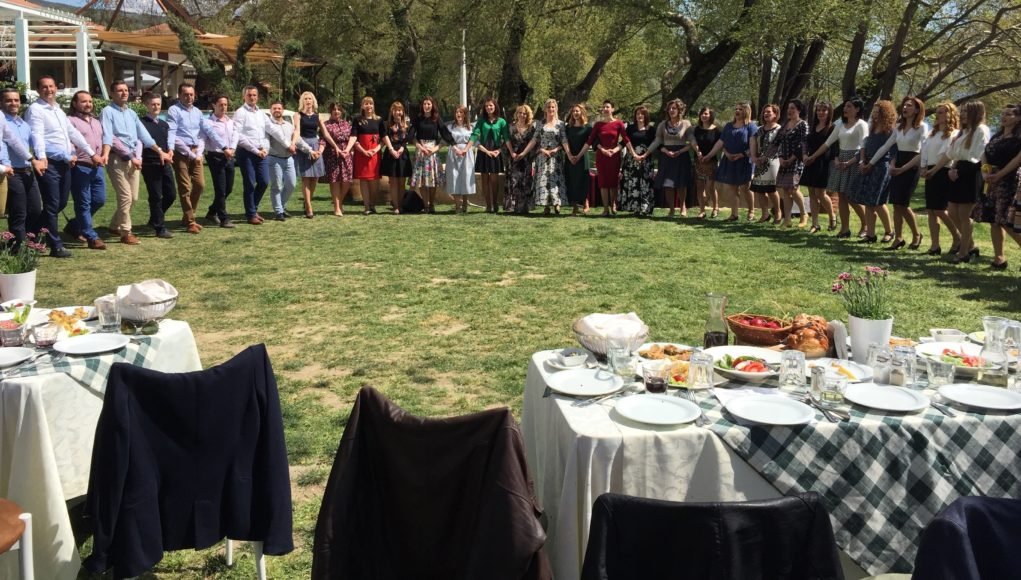
The Spirit of Togetherness
Greek Orthodox Easter embodies unity, love, and hope. It’s a time when cultural and communal traditions bind communities together, creating meaningful ways to celebrate the cycles of life. This festive period provides heartwarming opportunities for foreigners in Greece to connect with locals, fostering a sense of belonging and understanding amid the celebrations.
As spring blooms across Greece, participating in these celebrations provides not only a glimpse into the Greek way of life but also an opportunity for personal connection and joy. The atmosphere is vibrant, filled with folk music as people listen and dance! So, if you’re invited to join a Greek Easter table, be sure not to miss this unforgettable experience!
Glossary of Greek Easter Terms
- Kalo Pascha (Καλό Πάσχα!) : The Greek equivalent of “Happy Easter.” Literally translated, it means “Good Pascha” or “Good Easter.”
- Kali Anastasi (Καλή Ανάσταση) : A phrase used among Greeks to express joy about Christ’s resurrection. It literally translates to “Good Resurrection.”
- Christos Anesti (Χριστός Ανέστη) : A greeting exchanged by Greeks starting after midnight on Easter Sunday, meaning “Christ is Risen.”
- Alithos Anesti (Aληθώς ανέστη!) : The response to “Christos Anesti,” meaning “Truly, He is Risen.” This phrase is only used in reply to someone who has just greeted you with “Christos Anesti.”
Kalo Pascha! Happy Easter to all!




